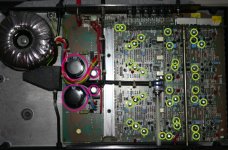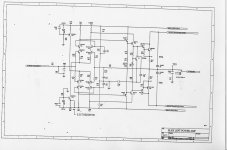Hi all - I'm new here, but I hope that my question is reasonable straight forward. I have a 20 year old Rega Elex amplifier (yup, 20 years old - it was the first run with the purple Rega logo) that has a problem with the right channel speaker output.
Independent of the volume pot and the selector pot, the right speaker crackles/hisses with no music making it through to that channel. I have a pair of heaphones attached to the tape out, and the amp provides a perfectly good output there.
Which component should I be looking at that may be causing this? Anybody have experience with this amp?
Independent of the volume pot and the selector pot, the right speaker crackles/hisses with no music making it through to that channel. I have a pair of heaphones attached to the tape out, and the amp provides a perfectly good output there.
Which component should I be looking at that may be causing this? Anybody have experience with this amp?
Hi,
Could be a dodgy connector, a dry joint or similar, sometimes
the power amplifier input transistors go noisy, unusual though.
rgds, sreten.
Could be a dodgy connector, a dry joint or similar, sometimes
the power amplifier input transistors go noisy, unusual though.
rgds, sreten.
Thanks sreten. I'll take a look over the right channel. I've just connected it up again, and realized the it is in fact amplified by the volume pot, but the noise/crackle is reasonable loud with the volume pot at zero.
I think the input is fine as when listened to via the tape out all is sounding good.
I think the input is fine as when listened to via the tape out all is sounding good.
first off, with an amp that age, shotgun replace all electrolytic capacitors. it could well be a bad coupling capacitor causing this problem.
Having looked at the schematic, it seems the preamp stage is passive - just a selector switch and the volume pot. So you've got a more serious problem I'd say. I'd look for dry joints but i'd say its probably more serious.
I'm not sure what level of expertise you have here to suggest further.
I'm not sure what level of expertise you have here to suggest further.
Panasonic are good brand capacitors - also look at cpc.farnell.com
It is right that they're about 2000-3000 hours of use. After 20 years, they are indeed overdue for replacement, especially if they're only 85c rated.
It is right that they're about 2000-3000 hours of use. After 20 years, they are indeed overdue for replacement, especially if they're only 85c rated.
The magenta ones are power supply capacitors... replacing those will help with sound quality but they wont be fault related.
Ooh, that looks like a lot of soldering. Be careful out there. Use a decent soldering iron and desoldering pump. If you are rusty, practice your technique on something else before starting off. 😉
Ooh, that looks like a lot of soldering. Be careful out there. Use a decent soldering iron and desoldering pump. If you are rusty, practice your technique on something else before starting off. 😉
Yeah, it sure does, and seeing that (a) replacing them may not even bring it back to life, and (b) there's 4 transistors under the silver rail that are stuck down to the casing so I can't even lift the pcb. Hmmmm.
What I thought may be a simple "A yes, a common problem with those amps - just ..." clearly isn't.
I'd love to bring it back to life because I also have the 'clamshell' Planet CD player.
Seeing that the noise is audible at a reasonable volume even with the volume down to zero, and that the volume pot does increase the volume of the noise, can I assume that the fault is before the volume pot and therefore before the attached diagram (I've only got the left channel but they are [basically] mirrored)?
[edit] hmmm, I'm thinking backwards here I think. If the noise is present even with the volume pot down at zero, then it's likely to be after the volume pot - or so my mixed up logic goes. But then what's it amplifying after the fault which would be after the volume pot in this scenario. [/edit]
[edit] hmmm, I'm thinking backwards here I think. If the noise is present even with the volume pot down at zero, then it's likely to be after the volume pot - or so my mixed up logic goes. But then what's it amplifying after the fault which would be after the volume pot in this scenario. [/edit]
Attachments
Last edited:
If you have an oscilloscope and you can disconnect the volume pot from the circuit, you could isolate the fault.
Unfortunately I don't have an oscilloscope, but I may be able to borrow one. I just investigated its behavior a little more today. I popped a 6v bulb onto the right channel output to try to test for loose components on the right channel, and spiking caused that to blow. I changed it to a 12v bulb and boy does it spike - very brightly, but not because of any prodding. I also noted when I removed the heatsink one of the A1186 transistors was getting hot quite quickly after switching on. What could be causing the transistor to get so hot so quickly when the other 3 are cold?
Ouch.. this is one thing you do not do with a power amp - never run it without the output transistors heatsinked. If one of the outputs wasn't blown before - it will be now.
Whoops. They are stuck down to the lower metal casing, and they were only run for a few moments, so crossed fingers. I think I'll send it to Rega!
Any update on this issue?
I know it's a bit late, but firstly, the circuit board is easy to remove. The u-shaped bar clamps the 4 output transistors to the chassis (they are insulated with heat sink tape); so just undoing the two screws will enable you to lift up and service the PC board. make sure you keep the surface of the exposed heatsink tape clean (cover with plastic) so it can be re-used.
I know it's a bit late, but firstly, the circuit board is easy to remove. The u-shaped bar clamps the 4 output transistors to the chassis (they are insulated with heat sink tape); so just undoing the two screws will enable you to lift up and service the PC board. make sure you keep the surface of the exposed heatsink tape clean (cover with plastic) so it can be re-used.
Hi mashley_nad - the output transistors were definitely stuck down to the bottom casing - whether by design on this mk1, or because of melt-down failure (?). I decided to send it to Rega for an overhaul. It's going to be repaired, plus all the caps will be replaced - it was always a lovely sounding amp with my mk1 Rega Ela speakers (the ones with the Royd drivers), so I'm looking forward to getting it back to life again.
I'm using a slightly younger Elex at the moment (a mk2 @ 17 years old) so it will be interesting to see what difference the capacitor replacement will make when I compare the two amps.
Cheers
Paul
I'm using a slightly younger Elex at the moment (a mk2 @ 17 years old) so it will be interesting to see what difference the capacitor replacement will make when I compare the two amps.
Cheers
Paul
I'd be interested to know how much the repair costs Paul, and if you notice any difference since I have an Elex MkII (1997) as well.
- Status
- Not open for further replies.
- Home
- Amplifiers
- Solid State
- Rega Elex problem pointer

